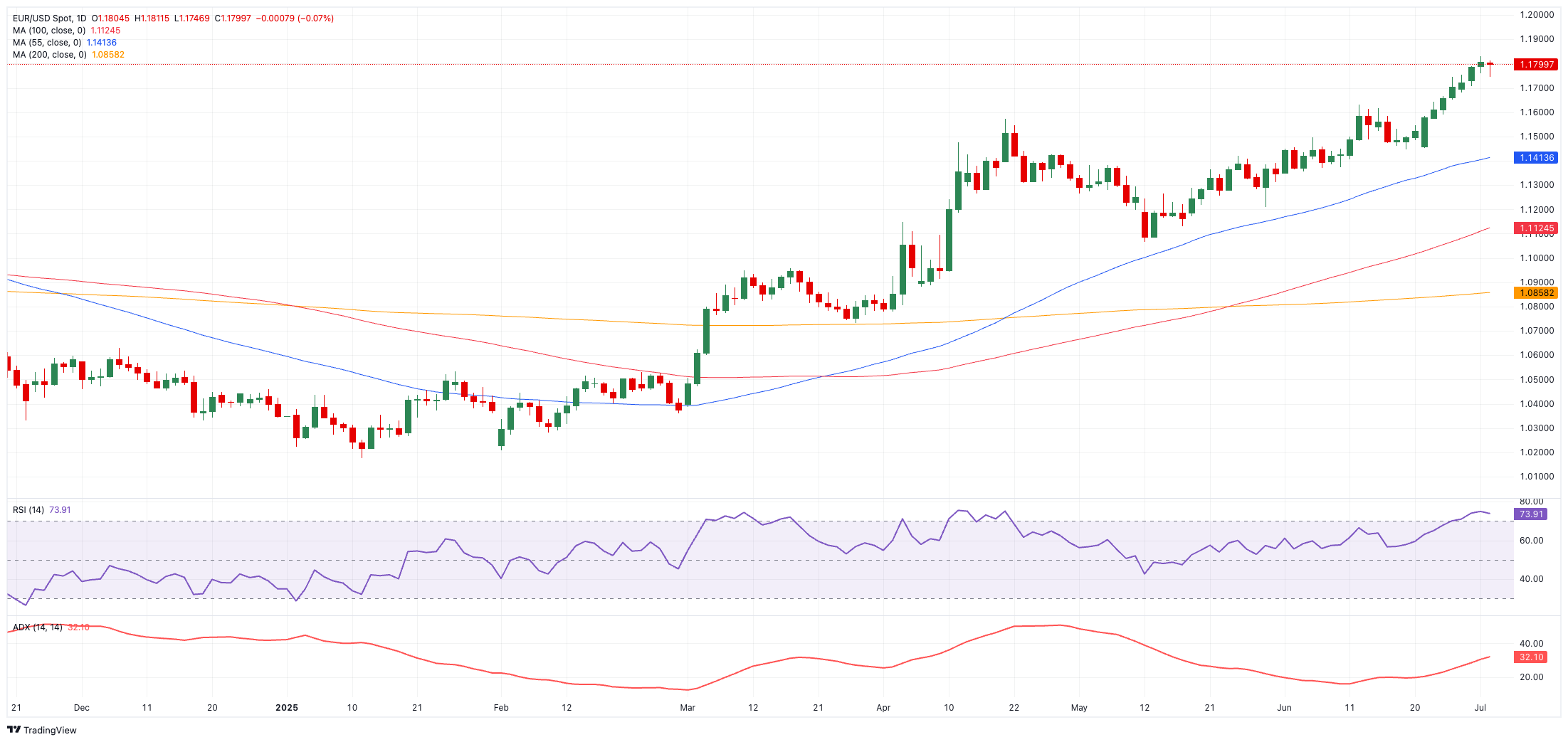
- EUR/USD retreated from recent peaks past the 1.1800 barrier.
- The US Dollar managed to gather some impulse amid higher yields.
- Market’s attention now shifts to the release of US NFP on Thursday.
The Euro (EUR) snapped a nine-day winning streak on Wednesday, with EUR/USD easing to the 1.1750 region following Tuesday’s fresh 2025 highs near 1.1830. The pair’s daily decline was primarily due to the rebound in the US Dollar (USD), although overbought conditions also played a role in the sudden change in price.
Political pressure on the Fed
Meanwhile, President Trump’s renewed criticism of Fed Chair Jerome Powell, who called for interest rates as low as “1% or lower” and accused the Fed leadership of dereliction of duty, did not affect the Greenback.
Geopolitics and risk sentiment
A fragile truce in the Middle East last week unleashed a renewed appetite for risk assets, weighing on the Dollar and giving the Euro and other risk-linked peers an extra lift.
Trade tensions remain front and centre
Investors remain wary as the July 9 deadline for the US tariff pause approaches. Meanwhile, the European Union (EU) is actively negotiating multiple trade agreements, including post-Brexit talks with the United Kingdom.
On this, President Trump said he wasn’t thinking about pushing out the July 9 deadline for tariffs and wasn’t sure whether an agreement could be reached with Japan. However, he did say that the US had made a deal with Vietnam and was hoping to do the same with India.
Policy divergence remains in the back burner
The Federal Reserve (Fed) held rates at 4.25%–4.50% in June but revised up its inflation and unemployment forecasts amid tariff-related cost pressures, with the dot plot still signalling 50 bp of easing this year.
By contrast, the European Central Bank (ECB) lowered its Deposit Facility Rate to 2.00% earlier this month, with President Christine Lagarde warning further easing will hinge on a clear drop in external demand.
Market positioning
CFTC data to June 24 show speculative net longs in the single currency rising to over 111.1K contracts, hitting the highest since January 2024. Meanwhile, Commercial traders’ net shorts increased to 164.3K contracts, a peak since December 2023. Open interest followed the move, reaching two-week highs around 762.6K contracts.
Technical levels
Immediate resistance sits at the 2025 ceiling of 1.1829 (July 1). A break above there would bring the September 2018 peak at 1.1815 (September 24) and the June 2018 high at 1.1852 (June 14) into focus.
On the downside, initial support lies at the transitory 55-day simple moving average (SMA) at 1.1410, seconded by the weekly trough at 1.1210 (May 29) and the May floor at 1.1064 (May 12), all ahead of the 1.1000 threshold.
Momentum indicators remain constructive: the Relative Strength Index (RSI) hovers above 74, hinting at stretched conditions but also further upside potential, while the Average Directional Index (ADX) near 31 points to a strengthening trend.
EUR/USD daily chart

Longer view
Absent fresh geopolitical or macro shocks, the Euro’s uptrend looks set to resume, underpinned by fading risk aversion and the prospect of Fed easing.
ECB FAQs
The European Central Bank (ECB) in Frankfurt, Germany, is the reserve bank for the Eurozone. The ECB sets interest rates and manages monetary policy for the region. The ECB primary mandate is to maintain price stability, which means keeping inflation at around 2%. Its primary tool for achieving this is by raising or lowering interest rates. Relatively high interest rates will usually result in a stronger Euro and vice versa. The ECB Governing Council makes monetary policy decisions at meetings held eight times a year. Decisions are made by heads of the Eurozone national banks and six permanent members, including the President of the ECB, Christine Lagarde.
In extreme situations, the European Central Bank can enact a policy tool called Quantitative Easing. QE is the process by which the ECB prints Euros and uses them to buy assets – usually government or corporate bonds – from banks and other financial institutions. QE usually results in a weaker Euro. QE is a last resort when simply lowering interest rates is unlikely to achieve the objective of price stability. The ECB used it during the Great Financial Crisis in 2009-11, in 2015 when inflation remained stubbornly low, as well as during the covid pandemic.
Quantitative tightening (QT) is the reverse of QE. It is undertaken after QE when an economic recovery is underway and inflation starts rising. Whilst in QE the European Central Bank (ECB) purchases government and corporate bonds from financial institutions to provide them with liquidity, in QT the ECB stops buying more bonds, and stops reinvesting the principal maturing on the bonds it already holds. It is usually positive (or bullish) for the Euro.
Information on these pages contains forward-looking statements that involve risks and uncertainties. Markets and instruments profiled on this page are for informational purposes only and should not in any way come across as a recommendation to buy or sell in these assets. You should do your own thorough research before making any investment decisions. FXStreet does not in any way guarantee that this information is free from mistakes, errors, or material misstatements. It also does not guarantee that this information is of a timely nature. Investing in Open Markets involves a great deal of risk, including the loss of all or a portion of your investment, as well as emotional distress. All risks, losses and costs associated with investing, including total loss of principal, are your responsibility. The views and opinions expressed in this article are those of the authors and do not necessarily reflect the official policy or position of FXStreet nor its advertisers. The author will not be held responsible for information that is found at the end of links posted on this page.
If not otherwise explicitly mentioned in the body of the article, at the time of writing, the author has no position in any stock mentioned in this article and no business relationship with any company mentioned. The author has not received compensation for writing this article, other than from FXStreet.
FXStreet and the author do not provide personalized recommendations. The author makes no representations as to the accuracy, completeness, or suitability of this information. FXStreet and the author will not be liable for any errors, omissions or any losses, injuries or damages arising from this information and its display or use. Errors and omissions excepted.
The author and FXStreet are not registered investment advisors and nothing in this article is intended to be investment advice.








